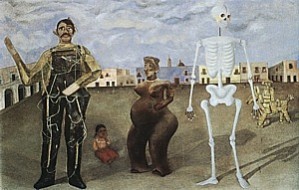Four
Inhabitants
of Mexico City
1938
In this painting, a small Indian girl, dressed in a typical Tehuana costume, appears with a cast of characters based on artifacts owned by the Riveras. Some say the little girl is Frida but the child lacks Frida's signature uni-brow. She may symbolize the Indian heritage within Frida. The cast includes a Judas, a pre-Columbian idol, a clay skeleton, and a straw man riding a donkey. They are all enclosed in a large arena, a plaza near her home in Coyoacan. In the far distance, the desolate buildings that surround the square include La Rosita, a bar where Frida and her art students painted murals in the 1940s and 1950s. "The plaza is empty," Frida said, "because too much revolution has left Mexico empty." The Judas represents the stereotypical macho male. His enormous size and the blue overalls identify him with Diego, who at one point kept a nearly identical Judas next to his easel. Next to the Judas is just the opposite, the passive pregnant female idol. The skeleton is a frequent player in the unfolding drama of Frida's art, for death was ever present within her. Frida said this one was "very gay, a joke", but it wouldn't have been funny to a child. Behind the skeleton, the straw man on his burrow captures the fragility of Mexican life. Frida painted him, she said, "because he is weak, and at the same time has such elegance and is so easy to destroy". Sitting on the ground, sucking her finger and clutching her skirt, the child looks lost and abandoned. None of the four inhabitants take any notice of her. She is connected to them only by their shadows. This is the only Kahlo painting in which there are shadows.
In November of 1938, this painting was shown at Kahlo's first solo exhibition at the Julien Levy Gallery in New York City. It was shown with the title: "The Square is Theirs".
This painting was auctioned by Sotheby's, New York, in May of 1996. It sold for $882.500.

(Click Here to View Larger Image)
(Pinche aquí para ver la imagen aumentada)
Oil
on metal
12 ¾" x 18 ¾"
Private Collection
Palo Alto, California, U.S.A
Óleo sobre metal
32,4 x 47,6
cm.
Colección privada
Palo Alto, California, EE.UU.
Cuatro
habitantes
de la Ciudad de México
1938
En este
cuadro, una pequeña niña India, vestida con un traje típico
de Tehuana, aparece con un grupo de caracteres basados en artefactos que
los Rivera poseían. Algunos dicen que la pequeña es Frida,
pero la niña no tiene la típica ceja única de Frida.
Ella podría simbolizar la herencia India dentro de Frida. El grupo
incluye un Judas, un ídolo pre-colombino, un esqueleto de arcilla
y un hombre de paja a lomos de un burro. Todos están incluidos
en una plaza que se hallaba cerca de su casa en Coyoacán. En la
lejanía, los edificios desolados que rodean la plaza incluyen "La
Rosita", un bar donde Frida y sus estudiantes de arte pintaron murales
en los años 40 y 50. "La plaza esta vacía,"
Frida dijo, "porque demasiada revolución ha dejado
a México vacío" . El Judas representa el estereotipo
del macho. Su enorme talla y el peto azul lo identifican con Diego, que
en un punto de su vida tenía un Judas prácticamente idéntico
al lado de su caballete. Al lado del Judas está su opuesto, un
pasivo ídolo femenino embarazado. El esqueleto es un carácter
que aparece a menudo en el drama que es el arte de Frida, ya que la muerte
siempre estuvo presente dentro de ella. Frida dijo que éste era
"muy alegre, una broma", pero a una niña pequeña
como la del cuadro no le hubiera parecido divertido. Detrás del
esqueleto, el hombre de paja sobre el burro captura
la fragilidad de la vida mexicana. Frida lo pintó, dijo, "porque
el es débil y al mismo tiempo tiene tanta elegancia y es tan fácil
de destruir" Sentada en el suelo, chupándose el dedo y
agarrando su falda, la niña parece perdida y abandonada. Ninguna
de las 4 personas que prestan atención a ella. Esta conectada a
ellos sólo a través de las sombras en el suelo. Este
es el único cuadro de Kahlo en donde se ven sombras.
En Noviembre de 1938, este cuadro se mostró en la primera exposición individual de Kahlo, en la Galería Julien Levy de Nueva York. Fue exhibida con el título: "The Square is Theirs" (La plaza les pertenece).
Este pintura se subastó en Sotheby's, New York, en Mayo de 1996. Se vendió por $882.500.